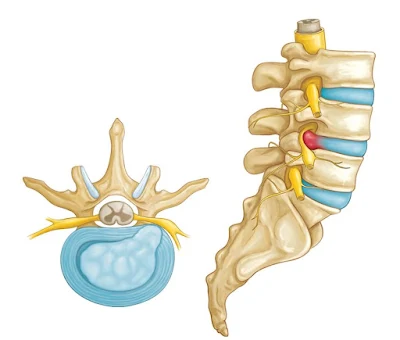What is disc tear?
The most common cause of a disc tear is a combination of disc degeneration and trauma to a spinal disc. The inner disc material pulls into the tear as a result of a disc tear, resulting in disc herniation.
A full disc herniation occurs when the material passes entirely through the outer layer of the spinal disc. A disc tear usually occurs as a result of trauma and is most commonly observed in the neck or lower back. But this doesn’t mean that they could not be found anywhere along the spine, it is simply rare in other places.
What are the causes of the tear?
When you twist, bend, or lift something heavy, the elastic in nature discs normally let the spine flex and absorb stresses. The discs begin to wear down as people become older. Like an underinflated tyre, they may flatten out or bulge outward. The disc's gelatinous material begins to dry out and stiffen, and the layers of the fibrous wall begin to separate and rip.
Inflammation occurs when a damaged disc pressures on neighboring spinal nerves. Disc ruptures in the lower spine usually impact the sciatic nerve roots on both sides of the discs as they exit the spine. The sciatic nerves run from the pelvis to the leg and ultimately to the foot. That's why a person will experience numbness, tingling, and discomfort in certain areas.
Weakening discs are more likely to rupture as a result of daily activities and labor, as well as sports, car crashes, and falls. It's difficult to connect a disc rupture to a specific event because it can happen as part of the disc's ageing process.
Is it possible for a tear to heal on its own?
In most cases, a damaged disc heals on its own in a few weeks to a month. As a result, most doctors recommend non-surgical treatments such as using a heating and cooling pad to relieve pain or doing mild exercises to strengthen your back. If the discomfort persists for months and becomes persistent, surgery may be considered.
What are the signs of a disc tear?
Numbness, discomfort, or tingling in the affected area are all symptoms of disc tears. If the disc is ripped in the neck, one may have discomfort in their shoulder or arm, whereas a disc torn in the lower back will lead to symptoms in the hips and toes. The symptoms may get worse over time, leading to a herniated disc.
How is the tear diagnosed?
The best way to diagnose a damaged slipped, or burst disc is through an MRI. Magnetic fields and radio-frequency waves are used to create an image of the spine that reveals the features of the disc, nucleus, and annulus. A professional can also do a myelogram, which is usually followed by a CT scan.
What is the best way to deal with a disc tear?
Back pain and sciatica caused by a disc usually go away on their own within a few weeks, however, at times it continues longer. Current treatment guidelines urge that the patient utilize self-care measures to relieve symptoms and wait for their back to recover.
Some of the remedies to be considered before surgery are,
- Staying and following an active lifestyle
- Exercise more than one hour for a minimum of four days every week
- Regular massage from a qualified chiropractor
When to start thinking about surgery?
If pain and sciatica last three months or more, it's deemed chronic and may require extra attention. Many people start to think about surgery at this point.
Anti-inflammatory steroid injections into the area around the irritated nerve and damaged disc may help delay surgery, but they aren't a long-term cure. Injections can provide short-term relief for a few months, but the effects eventually disappear. One can only be given a certain number of shots in a given year.
The judgment call to proceed with the surgery is a personal one. The doctor should go over all of the advantages and disadvantages with you so that the patient can make a more informed decision.
Diskectomy is the most prevalent procedure. It is a surgical procedure that removes a portion of a damaged disc so that it no longer pressures on the spinal nerve roots. It is often possible to perform it as an outpatient operation.
Disc tear treatment is not always successful, and the pain may worsen. It's possible that the disc will shatter again in the future, or that a different disc could fail.


Post a Comment